Optimization Model of Transit Route Fleet Size Considering Multi Vehicle Type
Abstract
:1. Introduction
2. Problem Statement
- (i)
- It does not consider the situation of two-way departure, so as to ensure the circulation of public transport vehicles;
- (ii)
- According to the passenger flow data, the bus operation time is divided into several periods, and the departure intervals are equal in the same period;
- (iii)
- Bus vehicles run in normal order, and there is no overtaking or jumping phenomenon. Headway of the vehicle arriving at the station is equal to departure intervals each period.
- (iv)
- Passengers arriving at the bus station are evenly distributed, and the public transit passenger flow is relatively stable at each time period. There is no passenger loss and all passengers can get on the car at one time;
- (v)
- Bus speed is only related to road traffic conditions, and it does not consider the impact of traffic accidents or road construction, and the speed of the bus is equal in the same period of time.
3. Proposed Model
3.1. Definition of Variables
- = hourly cost of personnel (¥/h);
- = unit fixed cost per h of bus size i (¥/h/bus);
- = unit cost per km covered by bus size i (¥/km);
- = headway of bus size i within period j (min);
- = maximum headway (min);
- = minimum headway (min);
- i = bus size type;
- I = number of bus size considered;
- j = period type;
- J = number of period considered;
- = capacity of bus size i (pax/bus);
- = departure number of bus size i in period j (buses);
- = total departure number of buses in period j (buses);
- = passenger volume in period j (pax);
- = passenger flow borne by bus size i in period j (pax);
- = cross-section passenger volume in period j (PCPV) (pax/h);
- = number of bus size i in period j (buses);
- = number of bus size i provided (buses);
- = total number of buses in period j (buses);
- = length of route r (km);
- = operator costs of route r (¥);
- = public transport route;
- = time length of period j (min);
- = length of departure time interval of bus size i within period j (min);
- = total costs of route r (¥);
- = user costs of route r (¥);
- = average speed of bus in period j (km/h);
- = weight coefficient of user costs;
- = weight coefficient of operator costs;
- = the fulfill load proportion in period j;
- = value of waiting time (¥/h).
3.2. Mathematical Model
3.3. Solution Methods
4. Numerical Analysis
4.1. Base Case
4.1.1. Inputs Values
4.1.2. Results of Base Case Study
4.2. Sensitivity Analysis
4.2.1. Cost Weight
4.2.2. Optional Bus Size
4.2.3. Cross-Section Passenger Volume
5. Conclusions
Author Contributions
Funding
Institutional Review Board Statement
Informed Consent Statement
Data Availability Statement
Acknowledgments
Conflicts of Interest
References
- Walters, A.A. Externalties in urban buses. J. Urban Econ. 1982, 11, 60–72. [Google Scholar] [CrossRef]
- Glaister, S. Bus deregulation, competition and vehicle size. J. Transp. Econ. Policy 1986, 20, 217–244. [Google Scholar]
- Oldfield, R.H.; Bly, P.H. An analytic investigation of optimal bus size. Transp. Res. Part B Methodol. 1988, 22, 319–337. [Google Scholar] [CrossRef]
- Lee, K.K.; Kuo, S.H.F.; Schonfeld, P.M. Optimal mixed bus fleet for urban operations. Transp. Res. Rec. 1995, 1503, 39–48. [Google Scholar]
- Fu, L.; Ishkhanov, G. Fleet size and mix optimization for paratransit services. Transp. Res. Rec. 2004, 1884, 39–46. [Google Scholar] [CrossRef] [Green Version]
- Jara-Díaz, S.R.; Gschwender, A. The effect of financial constraints on the optimal design of public transport services. Transportation 2009, 36, 65–75. [Google Scholar] [CrossRef]
- Dell’Olio, L.; Ibeas, A.; Ruisánchez, F. Optimizing bus-size and headway in transit networks. Transportation 2012, 39, 449–464. [Google Scholar] [CrossRef]
- Kim, M.; Schonfeld, P. Conventional, flexible and variable-type services. J. Transp. Eng. 2012, 138, 263–273. [Google Scholar] [CrossRef]
- Ceder, A.; Hassold, S.; Dano, B. Approaching even-load and even-headway transit timetables using different bus sizes. Public Transp. 2013, 5, 193–217. [Google Scholar] [CrossRef]
- Ibeas, A.; Alonso, B.; dell’Olio, L.; Moura, J.L. Bus Size and Headways Optimization Model Considering Elastic Demand. J. Transp. Eng. 2014, 140, 370–380. [Google Scholar] [CrossRef]
- Ibarra-Rojas, O.J.; Delgado, F.; Giesen, R.; Muñoz, J.C. Planning, operation, and control of bus transport systems: A literature review. Transp. Res. Part B Methodol. 2015, 77, 38–75. [Google Scholar] [CrossRef]
- Jara-Díaz, S.; Fielbaum, A.; Gschwender, A. Optimal fleet size, frequencies and vehicle capacities considering peak and off-peak periods in public transport. Transp. Res. Part A Policy Pract. 2017, 106, 65–74. [Google Scholar] [CrossRef]
- Vazquez-Abad, F.J.; Fenn, L. Mixed optimization for constrained resource allocation, an application to a local bus service. In 2016 Winter Simulation Conference (WSC); IEEE: Washington, DC, USA, 2016; pp. 871–882. [Google Scholar]
- Li, L.; Lo, H.K.; Xiao, F.; Cen, X. Mixed bus fleet management strategy for minimizing overall and emissions external costs. Transp. Res. Part D Transp. Environ. 2018, 60, 104–118. [Google Scholar] [CrossRef]
- Liang, S.; Ma, M.; He, S. The Impact of Bus Fleet Size on Performance of Self-equalize Bus Headway Control Method. Proc. Inst. Civ. Eng.-Munic. Eng. 2018, 172, 246–256. [Google Scholar]
- AlKheder, S.; Savsar, M.; AlRukaibi, F.; Zaqzouq, A. Optimal Fleet Size for Kuwait Public Transport Company Based on Integer Linear Programming. In Proceedings of the 2019 IEEE Intelligent Transportation Systems Conference (ITSC), Auckland, New Zealand, 27–30 October 2019; pp. 981–986. Available online: http://ieeexplore.ieee.org/document/8917210 (accessed on 2 October 2021).
- Liang, S.; Ma, M.; He, S. Multiobjective optimal formulations for bus fleet size of public transit under headway based holding control. J. Adv. Transp. 2019, 2019, 2452348. [Google Scholar] [CrossRef] [Green Version]
- Tian, Q.; Lin, Y.H.; Wang, D.Z. Autonomous and conventional bus fleet optimization for fixed-route operations considering demand uncertainty. Transportation 2020, 48, 2735–2763. [Google Scholar] [CrossRef]
- Jara-Díaz, S.; Fielbaum, A.; Gschwender, A. Strategies for transit fleet design considering peak and off-peak periods using the single-line model. Transp. Res. Part B Methodol. 2020, 142, 1–18. [Google Scholar] [CrossRef]
- Sun, Q.; Chien, S.; Hu, D.W.; Chen, G.; Jiang, R.S. Optimizing Multi-Terminal Customized Bus Service with Mixed Fleet. IEEE Access 2020, 8, 156456–156469. [Google Scholar] [CrossRef]
- Jiang, X.H.; Ma, J.X. Mixed Scheduling Model for Limited-Stop and Normal Bus Service with Fleet Size Constraint. Information 2021, 12, 400. [Google Scholar] [CrossRef]
- Salicrú, M.; Fleurent, C.; Armengol, J.M. Timetable-based operation in urban transport: Run-time optimisation and improvements in the operating process. Transp. Res. Part A Policy Pract. 2011, 45, 721–740. [Google Scholar] [CrossRef]
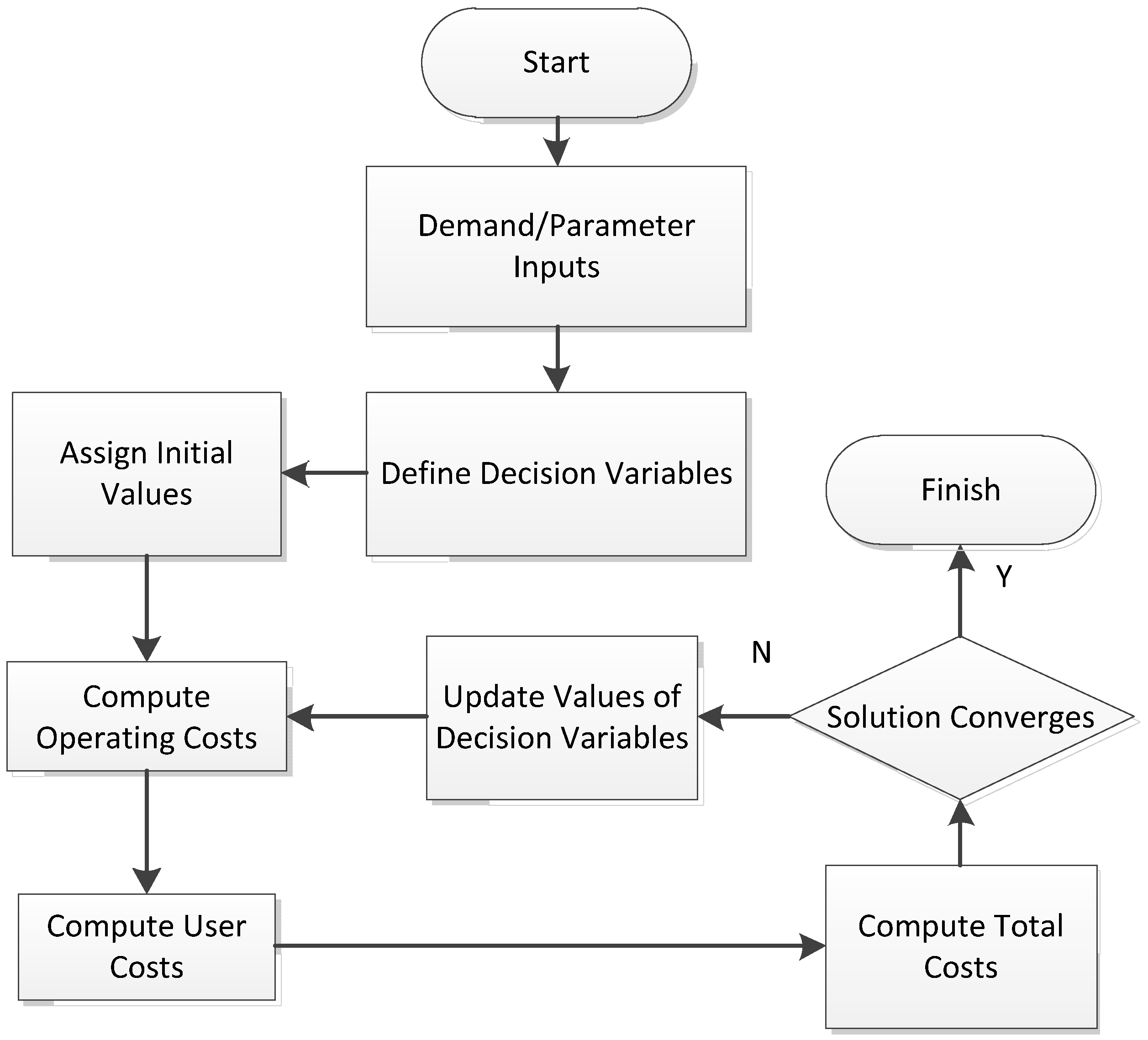

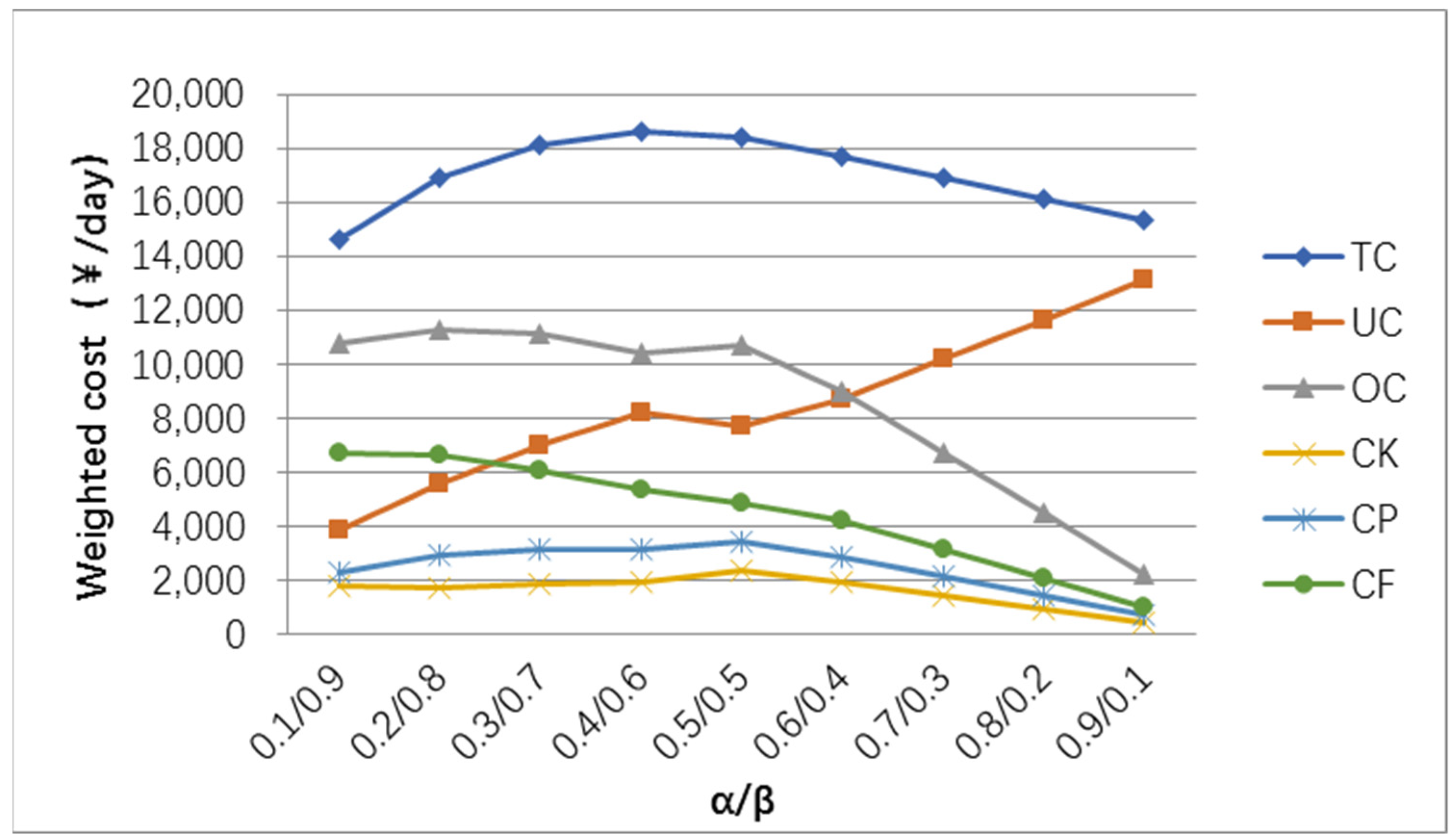
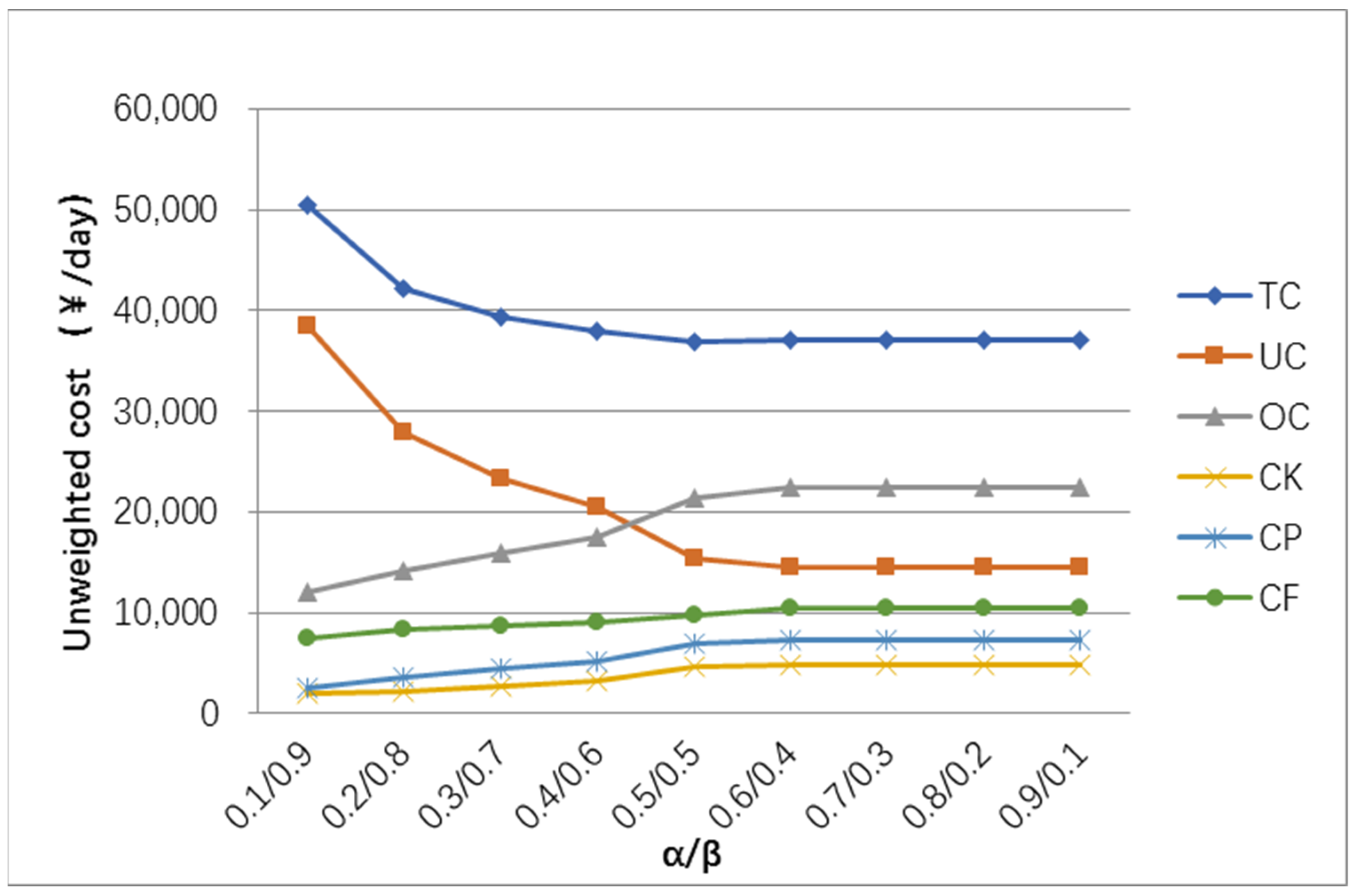

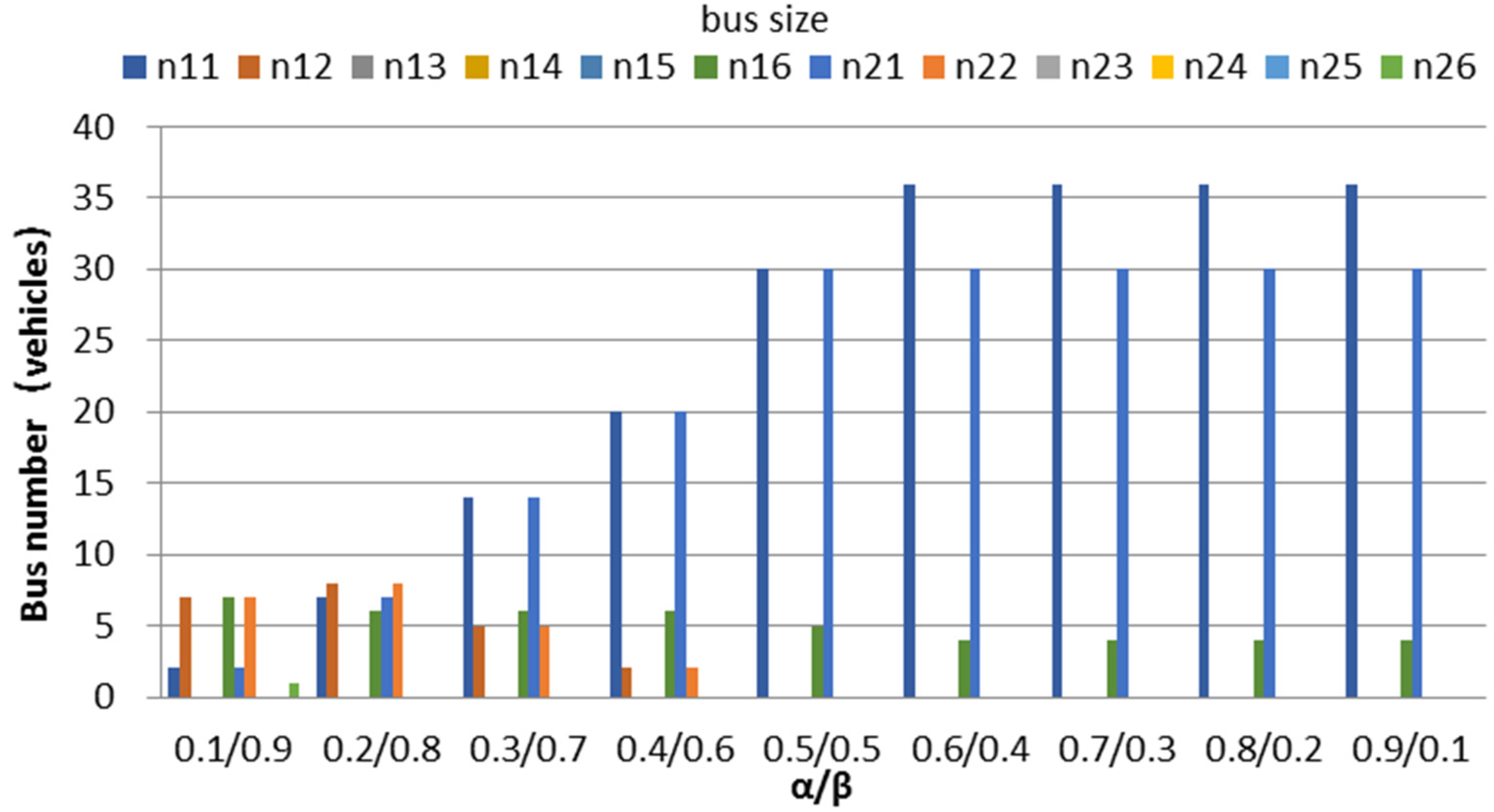
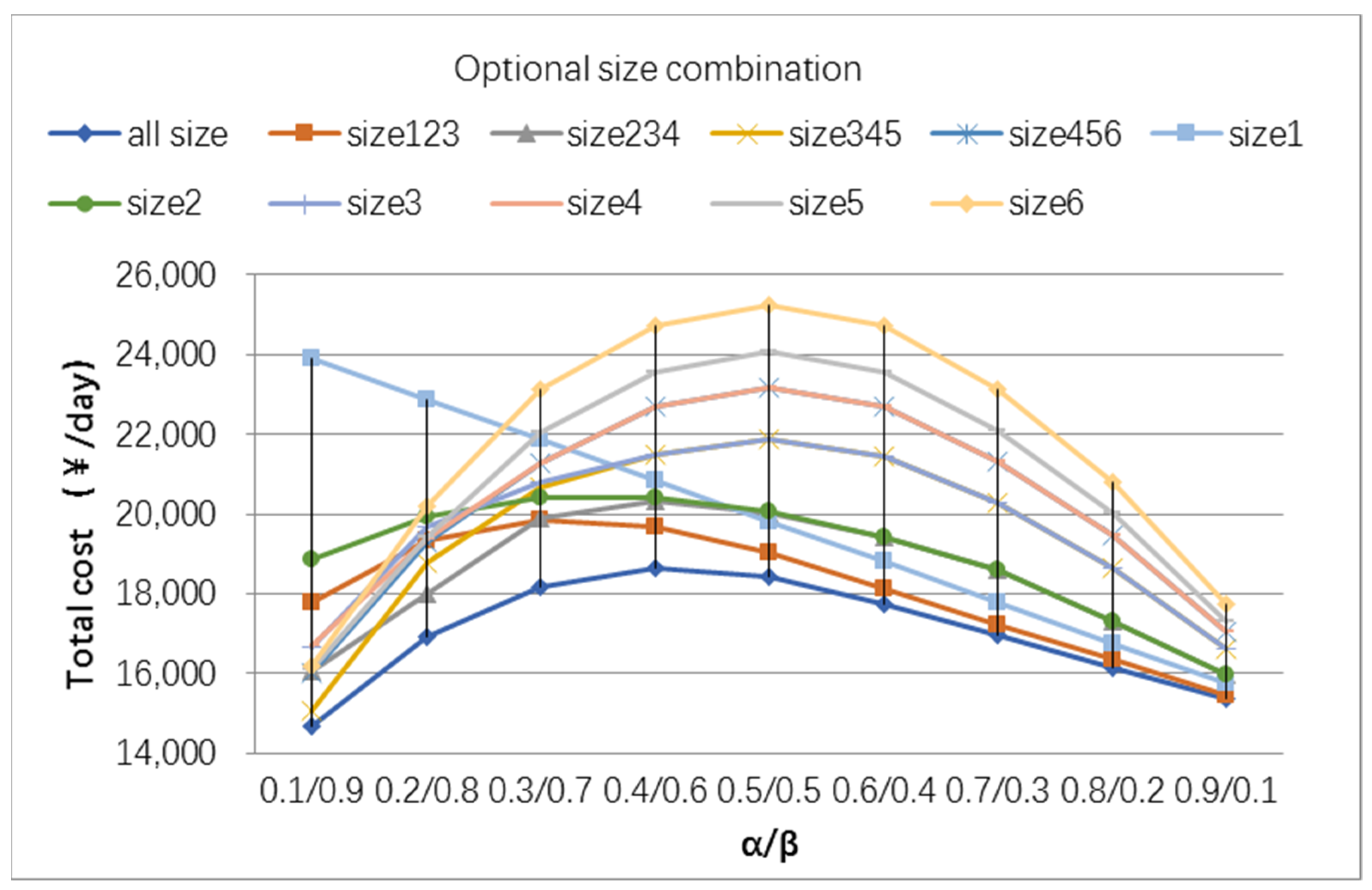
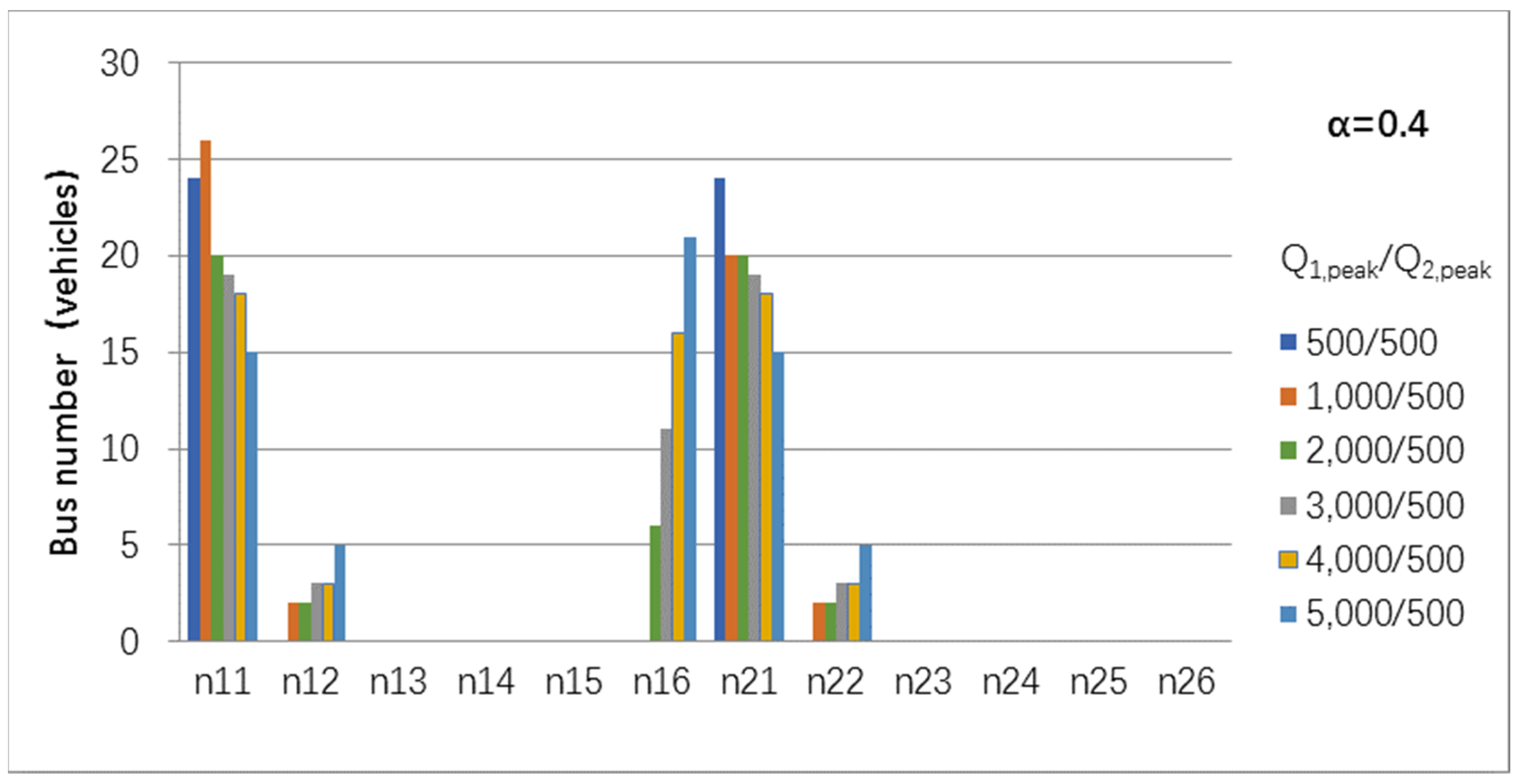
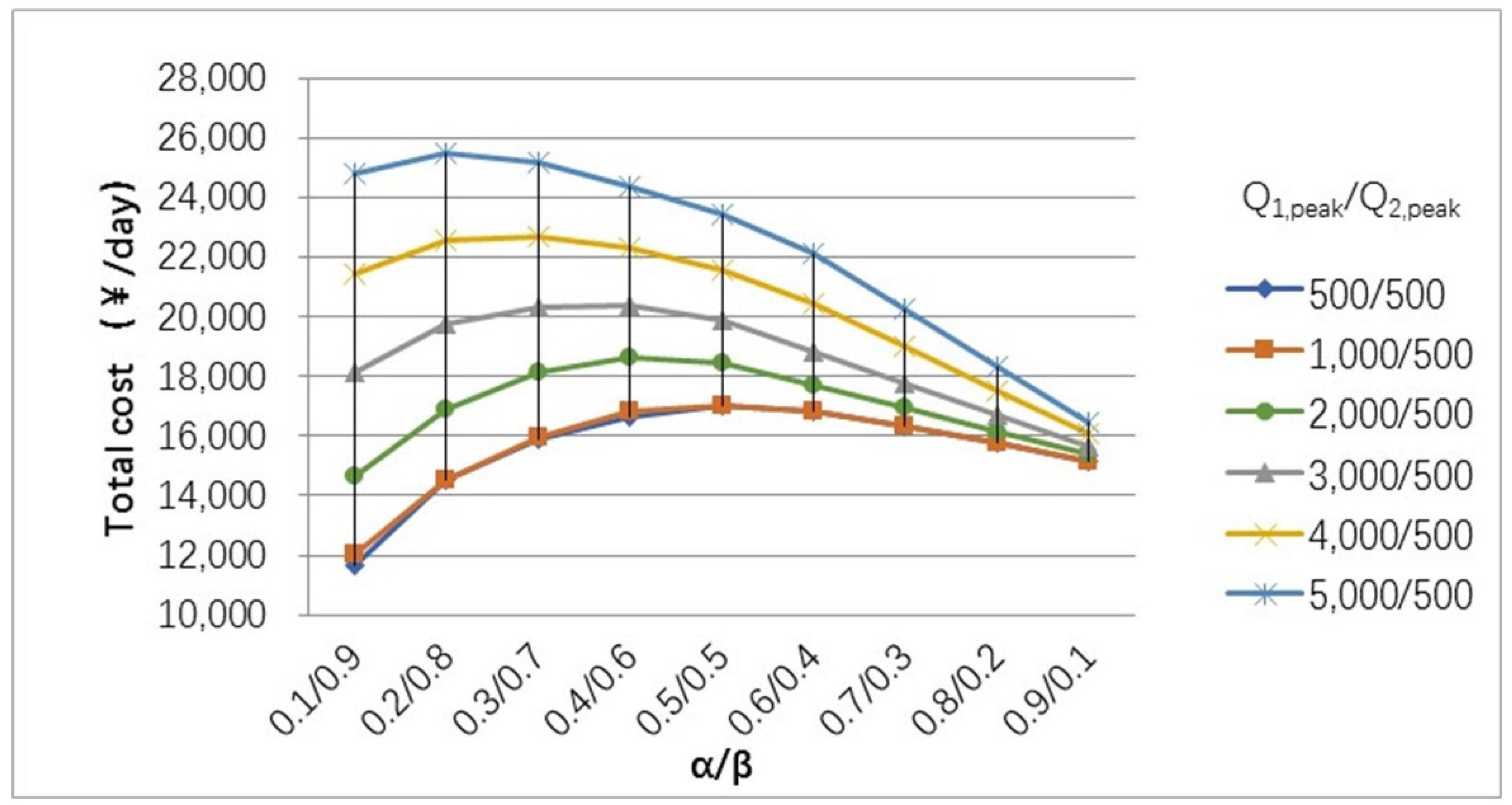
| Parameter | Unit | Numerical Value (i = 1, 2, 3, 4, 5, 6 or j = 1, 2) |
|---|---|---|
| pax/bus | 30, 60, 90, 120, 150, 180 | |
| ¥/h/bus | 15, 24, 32, 36,37, 42 | |
| ¥/km | 0.49, 0.71, 0.82, 1.04, 1.22, 1.40 | |
| pax/h | 15,000, 20,000 | |
| pax/h | 2000, 500 | |
| min | 240, 600 | |
| km/h | 15, 20 | |
| 1 | 1.3, 0.7 | |
| ¥/h | 15 | |
| ¥/h | 25 | |
| min | 20 | |
| min | 2 | |
| km | 10 | |
| 1 | 0.5 | |
| 1 | 0.5 |
| Parameter | Unit | Value | ||
|---|---|---|---|---|
| Before Optimization | After Optimization | Savings (%) | ||
| bus | = 30 | = 6 | / | |
| bus | = 12 | = 2 | / | |
| min | = 5.0 | = 2.8 | / | |
| TC | ¥/day | 21,808.71 | 18,651.00 | 14.48 |
| UC | ¥/day | 11,775.00 | 8197.89 | 30.38 |
| OC | ¥/day | 10,033.71 | 10,453.11 | −4.18 |
| CK | ¥/day | 1284.27 | 1948.27 | −51.70 |
| CP | ¥/day | 2257.92 | 3123.46 | −38.33 |
| CF | ¥/day | 6491.52 | 5381.38 | 17.10 |
Publisher’s Note: MDPI stays neutral with regard to jurisdictional claims in published maps and institutional affiliations. |
© 2021 by the authors. Licensee MDPI, Basel, Switzerland. This article is an open access article distributed under the terms and conditions of the Creative Commons Attribution (CC BY) license (https://creativecommons.org/licenses/by/4.0/).
Share and Cite
Liu, H.; Zhao, Y.; Li, J.; Li, Y.; Gao, X. Optimization Model of Transit Route Fleet Size Considering Multi Vehicle Type. Sustainability 2022, 14, 193. https://doi.org/10.3390/su14010193
Liu H, Zhao Y, Li J, Li Y, Gao X. Optimization Model of Transit Route Fleet Size Considering Multi Vehicle Type. Sustainability. 2022; 14(1):193. https://doi.org/10.3390/su14010193
Chicago/Turabian StyleLiu, Huasheng, Yuqi Zhao, Jin Li, Yu Li, and Xiangtao Gao. 2022. "Optimization Model of Transit Route Fleet Size Considering Multi Vehicle Type" Sustainability 14, no. 1: 193. https://doi.org/10.3390/su14010193





